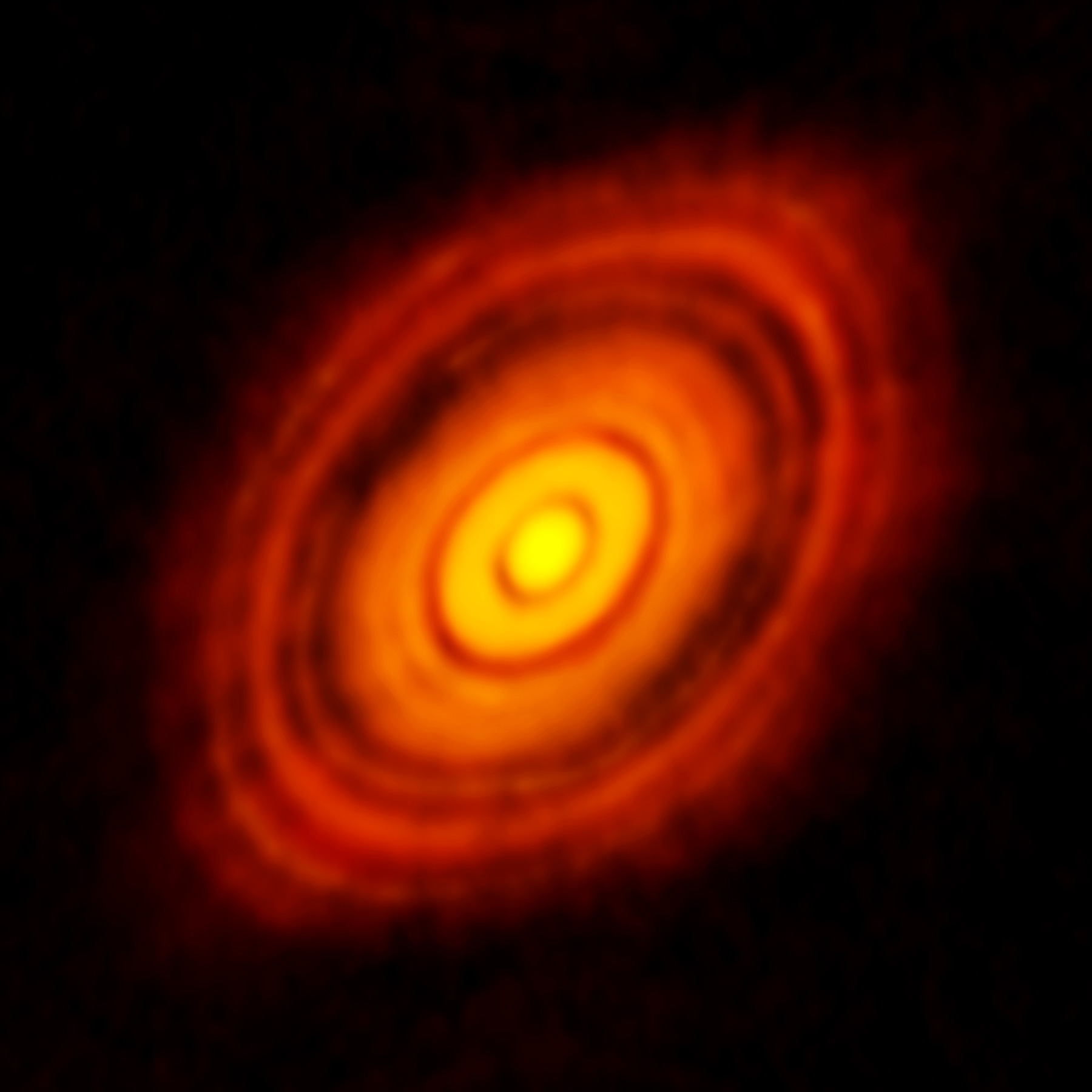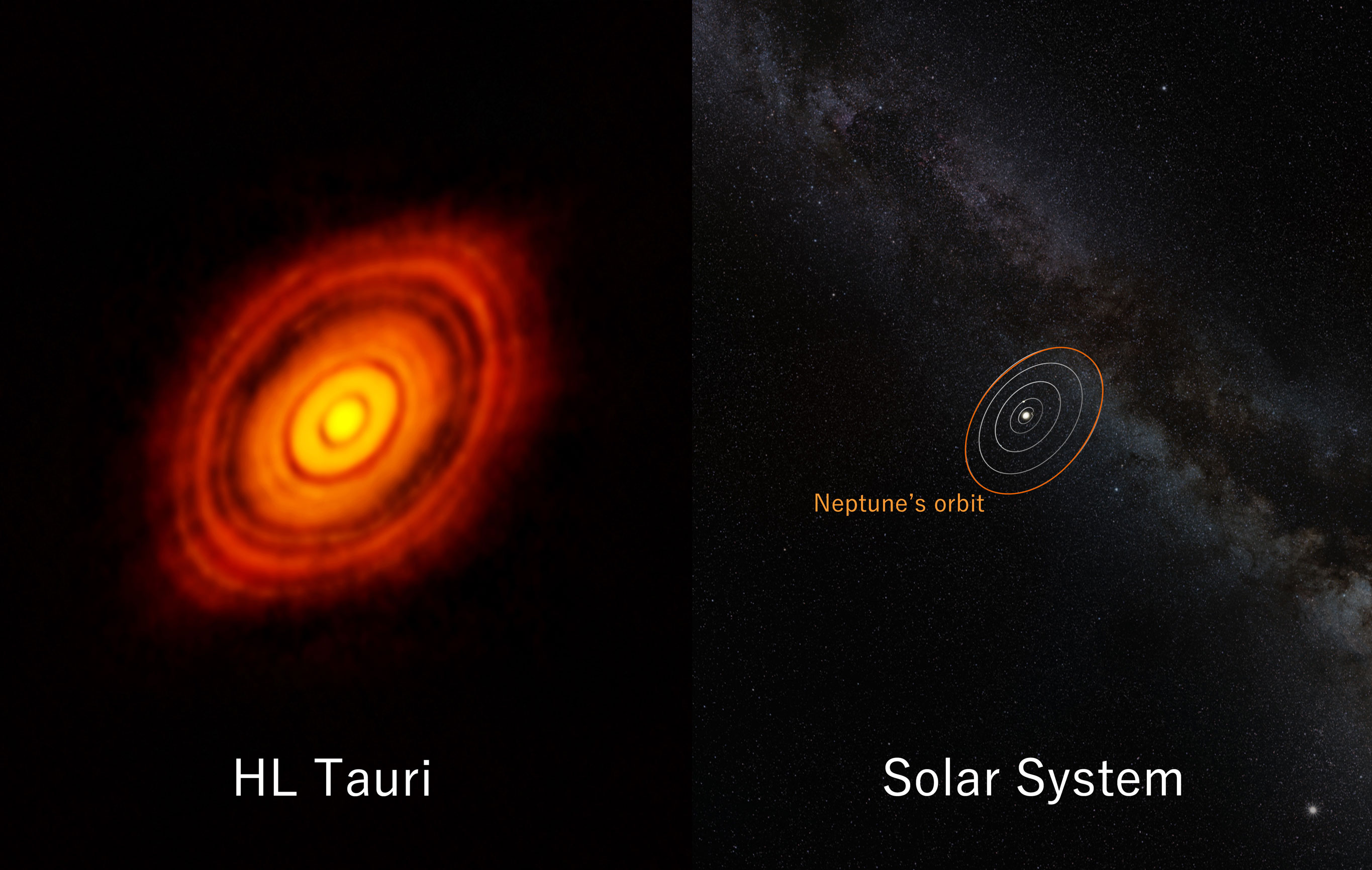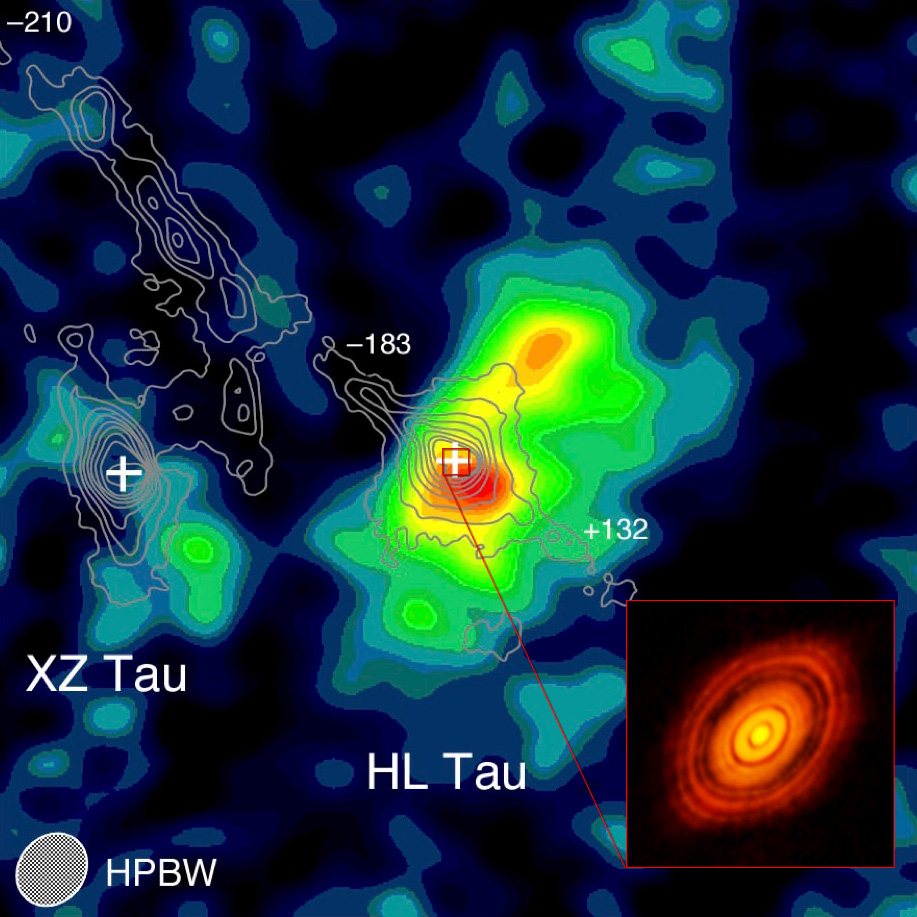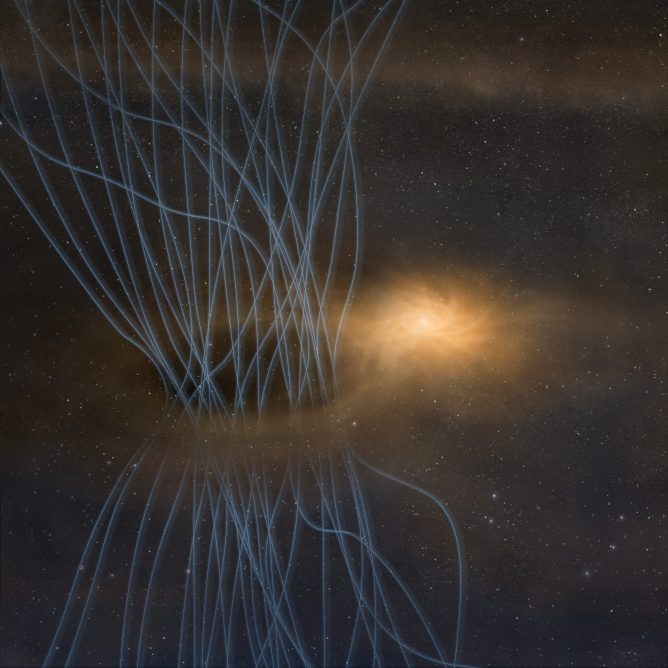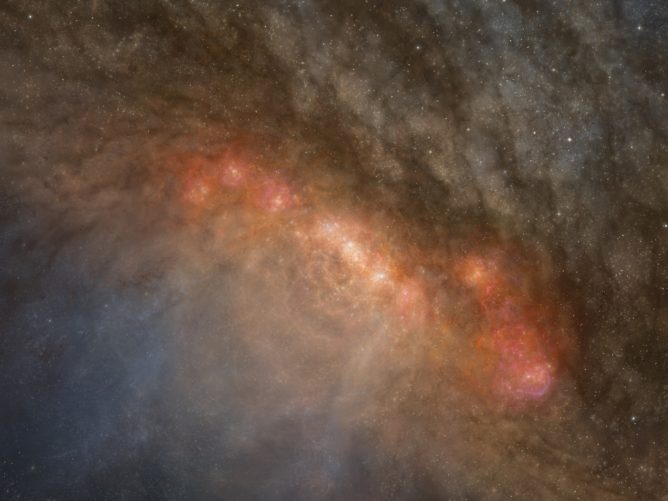Overview
Astronomers’ dream has just come true. The new image from ALMA, the Atacama Large Millimeter/submillimeter Array, reveals extraordinarily fine detail that has never been seen before in the planet-forming disk around a young star. These are the first observations that have used ALMA in its near-final configuration [1] and the sharpest pictures ever made at submillimeter wavelengths. The new results are an enormous step forward in the observation of how protoplanetary disks develop and how planets form.
Observations with ALMA
ALMA has obtained its most detailed image yet showing the structure of the disk around HL Tauri [2], a million-year-old Sun-like star located approximately 450 light-years from Earth in the constellation of Taurus. The image exceeds all expectations and reveals a series of concentric and bright rings, separated by gaps.
Figure 1. ALMA image of the protoplanetary disk around HL Tauri.
Credit: ALMA (ESO/NAOJ/NRAO)
Figure 2. Comparison of the size of the Solar System with HL Tauri and its surrounding protoplanetary disk. Although the star is much smaller than the Sun, the disk around HL Tauri stretches out to almost three times as far from the star as Neptune is from the Sun.
Credit: ALMA (ESO/NAOJ/NRAO)
“When we first saw this image we were astounded at the spectacular level of detail. HL Tauri is no more than a million years old, yet already its disk appears to be full of forming planets. This one image alone will revolutionize theories of planet formation,” explained Catherine Vlahakis, ALMA Deputy Program Scientist and Lead Program Scientist for the ALMA Long Baseline Campaign.
Such a resolution can only be achieved with the long baseline capabilities of ALMA and provides astronomers with new information that is impossible to collect with any other facility, even the Hubble Space Telescope. “The logistics and infrastructure required to place antennas at such distant locations required an unprecedented coordinated effort for the international expert team of engineers and scientists” said ALMA Director, Pierre Cox. “These long baselines fulfill one of ALMA’s major objectives and mark an impressive technological, scientific and engineering milestone”, celebrated Cox.
Stars like HL Tauri and our own Sun form within clouds of gas and dust that collapse under gravity. Over time, the surrounding dust particles stick together, growing into sand, pebbles, and larger-size rocks, which eventually settle into a thin disk where asteroids, comets, and planets form. Once these planetary bodies acquire enough mass, they dramatically reshape the structure of the disk, fashioning rings and gaps as the planets sweep their orbits clear of debris and shepherd dust and gas into tighter and more confined zones.
In the visible, HL Tauri is partly obscured by the massive cloud of dust and gas that surrounds it. ALMA operates in such a way that it can see through the cloud and study the processes right at the center. This new ALMA image provides the clearest evidence to date that not only does this process occur, but also that it is faster than previously thought.
The investigation of these protoplanetary disks is essential to our understanding of how Earth formed in the Solar System. Observing the first stages of planet formation around HL Tauri may show us how our own planetary system may have looked more than four billion years ago, when it formed.
“I had never dreamed that at this early phase of operations ALMA would image such a vivid picture showing the formation of a planetary system” told Dr. Masahiko Hayashi, the Director General of the National Astronomical Observatory of Japan, who is an astronomer specializing in star and planet formation. “I learned the Kyoto Model [3] of solar system formation when I was an undergraduate, but never imagined that I would see in my lifetime observations actually revealing such details of the planetary system formation process. I’m now confident that we can move to the next step, the search for signs of life in the Universe. I believe we could find other life-bearing worlds while I am still in this world.”
Figure 3.Composite image of the young star HL Tauri and its surroundings using data from ALMA (enlarged in box at upper right) and the NASA/ESA Hubble Space Telescope (rest of the picture). This is the first ALMA image where the image sharpness exceeds that normally attained with Hubble.
Credit: ALMA (ESO/NAOJ/NRAO)/NASA/ESA
Figure 4. Comparison of the young star HL Tauri observed by the Nobeyama Millimeter Array (NMA) in 1993 and ALMA in 2014. The resolution of the NMA image is 5 arcseconds. Now ALMA’s resolution exceeds NMA by a factor of 140.
Credit: NAOJ/ALMA (ESO/NAOJ/NRAO)
Movie. This video takes you to the location of HL Tauri in the constellation of Taurus and reveals the astonishing depth and detail that ALMA can now attain. HL Tauri is located at a distance of 450 light-years. The start of the sequence shows a wide view, including the Pleiades and Hyades naked eye star clusters. We then zoom into a very detailed visible-light image from the NASA/ESA Hubble Space Telescope and the final part shows the new ALMA image at millimeter wavelengths.
Credit: ALMA (ESO/NAOJ/NRAO)/NASA/ESA/N. Risinger (skysurvey.org). Music: movetwo
Full HD Movie (MPEG4, 1920×1080, 49.8MB)
Notes
[1] Since September 2014 ALMA has been observing the Universe using its longest ever baselines, with antennas separated by up to 15 kilometers. This Long Baseline Campaign will continue until 1 December 2014. The baseline is the distance between two of the antennas in the array. As a comparison, other facilities operating at millimeter wavelengths provide antennas separated by no more than two kilometers. Future observations at shorter wavelengths will achieve even higher image sharpness.
[2] The structures are seen with a resolution of just five times the distance from the Sun to the Earth. This corresponds to an angular resolution of about 35 milliarcseconds — better than what is routinely achieved with the NASA/ESA Hubble Space Telescope.
[3] Kyoto Model is a prototypical planet formation model proposed by Prof. Chushiro Hayashi at Kyoto University, in which planets are formed in gas and dust disk with the mass of 0.01-0.04 solar masses.

